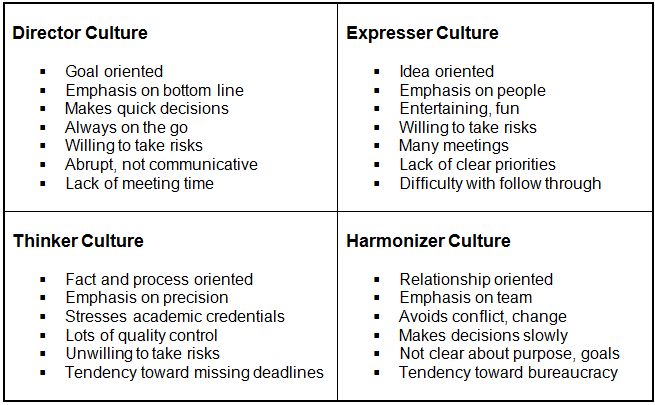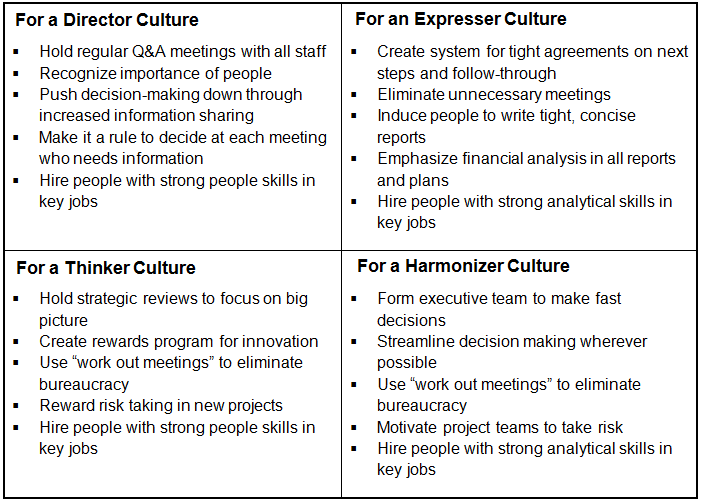
Understanding Organizational Cultures
How can you determine an organization’s style? If it’s a relatively small organization, start with the CEO. Nine times out of ten, their style will dictate the style of the organization. For a larger organization, with say more than 100 employees, the division heads or senior management team will determine the culture. If they tilt toward a particular style, the organization will mirror that.
A lack of balance in senior management will affect the styles of hundreds, even thousands, of subordinates, and cause the organization to behave in predictable ways.
The following chart shows the predictable tendencies of each different type of culture:
Achieving a Balanced Culture
The Rule of the Center is as true for organizations as it is for individuals. It’s just that organizations can’t shift styles as easily as individuals. When an organization is out of balance, it has only three options:
1) Add senior level people with styles that balance the prevailing style
2) Create systems to correct imbalances by rewarding specific behaviors
3) Accept the status quo
CEOs and presidents of organizations, in particular, need to recognize their role in shaping a culture. When a boss is aware of their own style, they can make a conscientious effort to motivate behaviors in the organization that balances his or her style. Typically, these behaviors can be induced by creating specific systems and processes within the organization.
- For example, in a Director culture, you can make sure that enough meetings are scheduled to keep people informed and involved.
- In a Harmonizer culture, you can create an executive team and empower it to make critical decisions.
- In an Expresser culture, you can insist that people form tight agreements about what needs to be done when.
- And in a Thinker culture, you can reward people for innovative thinking.
The following chart contains a checklist of possible actions that can be taken to address the weaknesses that crop up in each type of culture.
Knowing how to achieve a balance of styles is a sign of mature management.
But the reverse occurs more frequently. The boss selects subordinates who are similar in style to his or her own; key managers reinforce behaviors they’re comfortable with, rather than those that might provide the necessary balance.
The managers of every organization imbue its culture with certain habits and tendencies.
Over time, these habits become the source of discontent and unresolved conflict. By analyzing the style of top managers, using the Communication Styles Profile, one can discern the source of an organization’s culture, and isolate possible causes. Finding the right balance of management styles is management’s top responsibility – along with ensuring that each style understands its importance to the organization.
| Lesson 19: When Ground Rules Aren’t Enough | Lesson 21: Communication Styles at Work in Others |
4 Comments
Add yours+ Leave a Comment
You must be logged in to post a comment.




[…] Previous: Organizational Cultures […]
[…] Previous: Organizational Cultures […]
[…] Lesson 20: Understanding Organizational Cultures […]
Understanding organizing cultures is a must. I believe that in internal branding it needs to be given an action plan for this.